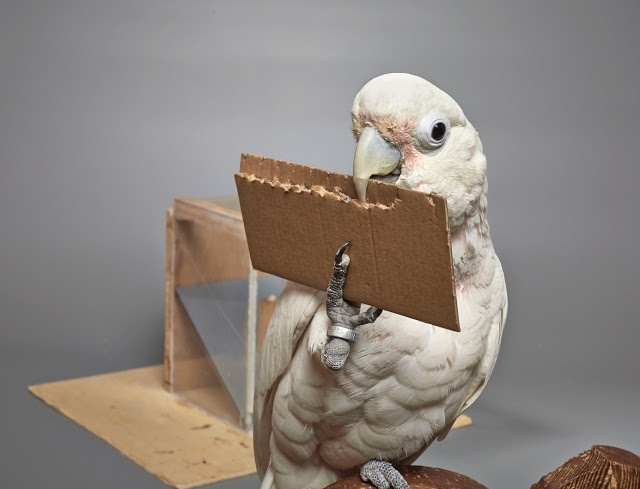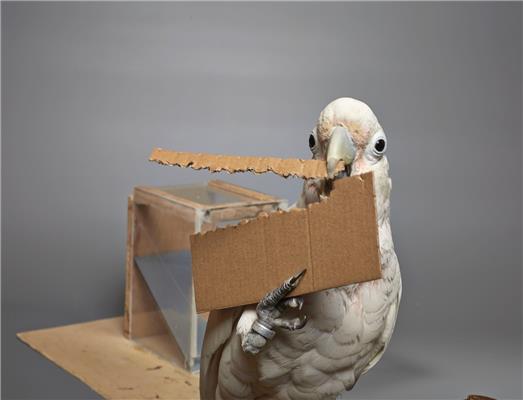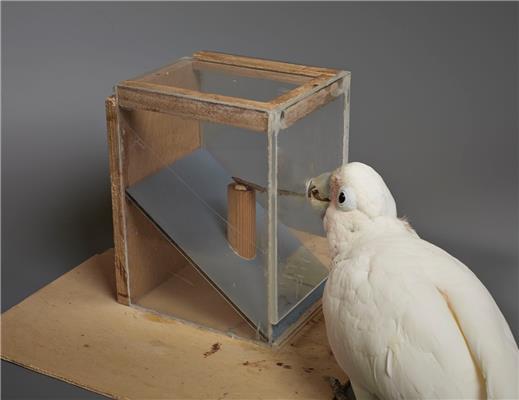

| Online: | |
| Visits: | |
| Stories: |

| Story Views | |
| Now: | |
| Last Hour: | |
| Last 24 Hours: | |
| Total: | |
Cockatoos Concocting Tools Surprise Scientists
Tool manufacture was once regarded a defining feature of mankind, but it is now known that a variety of animal species use and make their own tools
Goffin’s cockatoos do not use or forge tools in nature. They are however able to shape tools out of different materials like cardboards.
Photo: Bene Croy
Why and how cockatoos can use tools so far cloudy
The Goffin’s cockatoo, which is native to Indonesia, is neither known to use tools in the wild nor to have evolved related abilities for manipulating twigs for other purposes such as nest building. One bird, called Figaro, previously displayed the ability to spontaneously (ie without training) make tools by biting long splinters out of the wooden beams of its cage, which he then used to rake pieces of food that were otherwise out of reach. Three others have since followed, showing that making such tools is within the capacity of the species.
Cockatoos can even use cardboard for shaping tools
To test if the birds were in fact aiming to make elongated tools that could bridge a particular distance, the researchers gave them the problem of reaching a piece of food placed a few centimeters beyond a circular hole in the transparent wall of a box. They were given four different materials that required different manipulations to produce suitable tools: larch wood (already familiar to them), leafy beech twigs (which had to be trimmed to be functional), cardboard (which, lacking a fibrous structure, could be cut into any shape and length), and totally amorphous beeswax.
Dr Alice Auersperg, who heads the Goffin Laboratory in the Messerli Research Institute at the University of Veterinary Medicine, Vienna, said: ‘While none of the birds succeeded in making tools out of beeswax, we found that at least some of them could make suitable tools from the three remaining materials.’
The successful parrots made well-shaped tools, even though each material required different manipulation techniques. To make tools out of larch wood they bit the material once or twice and teared the resulting splinter off. To use the leafy twigs they snapped off redundant leaves and side branches until what was left was usable. Finally, to make cardboard tools they just cut what was necessary from the edge of the sheet provided.
New aspects for behavioral scientists
Dr Auersperg added: ‘To us, the tools made from cardboard were the most interesting ones, as this material was not pre-structured and required the birds to shape their tools more actively. They succeeded by placing a large number of parallel bite marks along the edge of the material like a hole punch, using their curved upper beak to cut the elongated piece out of the cardboard block after reaching a certain length. Interestingly, this length was usually just above or very close to the minimum length required to reach the food reward placed behind the barrier.’
Co-author Professor Alex Kacelnik, from the University of Oxford’s Department of Zoology, said: ‘Ultimately, we want to understand how animals think – namely, to produce the equivalent of explicit computer programs capable of doing what the birds do. We really don’t know if the birds can picture in their minds an object that doesn’t yet exist and follow this image as a template to build something new, or how their brains elicit the appropriate set of movements to organize their response to novel problems, but this is what we are trying to find out.
‘Studying tool-making in species like the Goffin’s cockatoo, which does not make tools naturally, is especially revealing, as these birds cannot do it by following pre-programmed instructions evolved to solve this specific problem. These cockatoos, like other parrots, offer wonderful research opportunities: their intelligence is flexible and powerful, they can solve physical and logical problems, they can learn from watching the behavior of others, they can learn about the surrounding objects by playing – and now it seems plausible that they can imagine which object would allow them to solve a new problem and go on to build it. I am sure that they will keep surprising us.’
Contacts and sources:
Alice Auersperg, Messerli Research Institute
University of Veterinary Medicine Vienna (Vetmeduni Vienna)
Stuart Gillespie, University of Oxford
Source:





